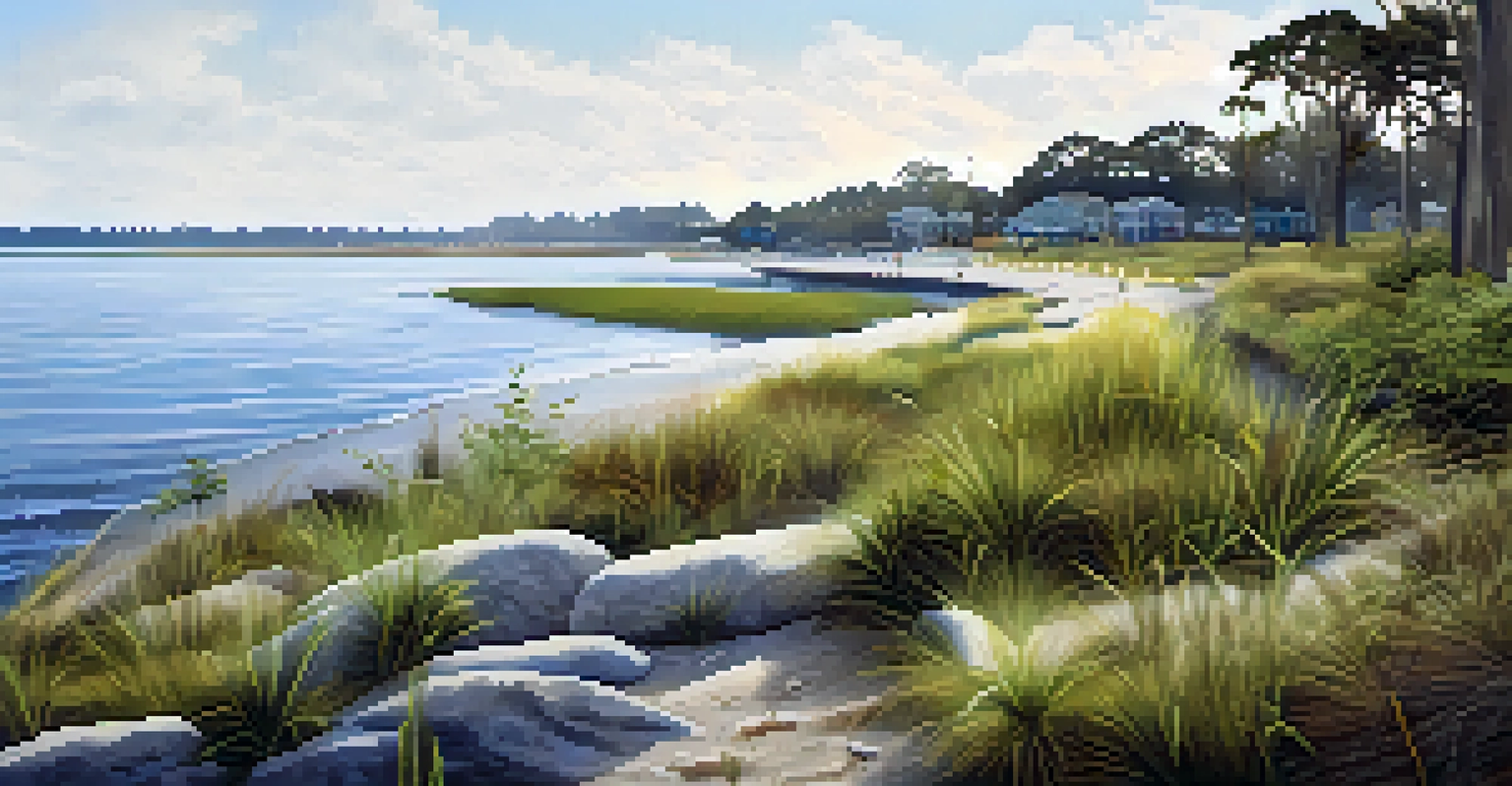Coastal Resilience: Savannah's Strategies Against Erosion

Understanding Coastal Erosion in Savannah
Coastal erosion poses a significant threat to Savannah, affecting its landscapes and communities. This natural process, where land is worn away by wave action, currents, and tides, has intensified due to climate change. As sea levels rise, Savannah's picturesque coastlines face increased vulnerability, prompting the need for proactive strategies.
The coast is an integral part of our identity, and protecting it is not just a responsibility but a necessity for future generations.
In the past, erosion was often viewed as an inevitable part of coastal life, but the stakes have changed. Homes, businesses, and essential infrastructure are all at risk, making it crucial for local leaders and residents to address this pressing issue. With a rich history and cultural heritage, Savannah cannot afford to lose its coastal charm to erosion.
Understanding the causes and impacts of coastal erosion is the first step in the fight for resilience. By raising awareness and engaging the community, Savannah can develop more effective solutions that not only protect the coast but also preserve the city’s identity.
Community Engagement and Education Initiatives
Savannah's approach to coastal resilience heavily emphasizes community involvement and education. Local organizations conduct workshops and informational sessions to teach residents about the effects of erosion and the importance of preserving coastal ecosystems. By fostering a sense of ownership, the community becomes more invested in protective measures.

Moreover, engaging the community helps to collect valuable local knowledge, which can inform better decision-making. Residents often have firsthand experience and observations that can shed light on erosion patterns and effective strategies. This collaborative effort not only strengthens community bonds but also enhances the effectiveness of resilience initiatives.
Community Engagement Drives Resilience
Savannah's focus on community involvement and education empowers residents to take an active role in combating coastal erosion.
Through educational initiatives, Savannah empowers its citizens to become advocates for their environment. When individuals understand the risks and solutions, they are more likely to participate in ongoing efforts to combat erosion and create a safer, more resilient coastal area.
Natural Solutions: Restoring Coastal Ecosystems
One of Savannah's key strategies against erosion is the restoration of natural coastal ecosystems. Mangroves, salt marshes, and dunes play a crucial role in absorbing wave energy and stabilizing shorelines. By investing in the restoration of these habitats, Savannah can enhance its natural defenses against the forces of nature.
Community engagement is the cornerstone of effective environmental stewardship; when people understand the risks, they become the best advocates for their own coastline.
For example, replanting native vegetation along the coast not only helps to anchor the soil but also provides essential habitats for wildlife. These ecosystems are resilient and can adapt to changing conditions, making them invaluable allies in the fight against erosion. The city’s commitment to ecological restoration reflects a broader understanding of the interconnectedness of human and natural systems.
Additionally, these natural solutions often come with other benefits, such as improved water quality and increased biodiversity. By prioritizing the restoration of coastal ecosystems, Savannah is not just combating erosion; it is creating a healthier environment for both people and wildlife.
Innovative Infrastructure Projects for Erosion Control
In conjunction with natural solutions, Savannah is also investing in innovative infrastructure projects to combat erosion. These include the construction of seawalls, breakwaters, and living shorelines that serve to protect vulnerable areas. Such projects are designed not only to withstand storm surges but also to enhance the aesthetics of the coastline.
For instance, living shorelines incorporate natural elements, such as plants and sediment, to create a buffer against wave action. This approach not only mitigates erosion but also provides vital habitats for marine life. By blending infrastructure with natural systems, Savannah can achieve a more sustainable and effective solution to erosion.
Natural Solutions Enhance Coastal Defense
Restoring natural ecosystems like mangroves and marshes not only mitigates erosion but also enriches biodiversity in Savannah.
These projects require careful planning and collaboration among engineers, ecologists, and community members. By involving various stakeholders, Savannah ensures that the solutions implemented are not only effective but also considerate of the local environment and community needs.
Policy and Planning: A Framework for Resilience
Effective policies and planning are fundamental to Savannah's coastal resilience strategies. The city has established guidelines that prioritize sustainable development and erosion control in at-risk areas. By integrating these policies into urban planning, Savannah can proactively address the challenges posed by coastal erosion.
Local government plays a pivotal role in ensuring that new developments are designed with resilience in mind. This means considering factors like elevation, drainage, and landscaping to minimize vulnerabilities. Additionally, policies that promote community engagement in decision-making processes help to build trust and accountability.
Savannah's comprehensive approach to policy and planning signifies a commitment to long-term resilience. By laying a strong foundation, the city is better equipped to adapt to changing conditions and protect its cherished coastal heritage for future generations.
Collaboration with Regional and National Partners
Addressing coastal erosion is not just a local issue; it requires collaboration with regional and national partners. Savannah has formed alliances with environmental organizations, government agencies, and research institutions to leverage expertise and resources. These partnerships enhance the city’s ability to develop effective strategies and share best practices.
For example, working with federal agencies can provide access to funding and technical assistance for large-scale projects. Collaborative efforts often result in more comprehensive solutions that incorporate the latest research and innovations in coastal management. This synergy amplifies the impact of local initiatives, creating a network of support for resilience efforts.
Collaborative Efforts Strengthen Strategies
Partnerships with regional and national entities enhance Savannah's capacity to implement effective erosion control measures.
Furthermore, sharing knowledge and experiences with other coastal communities fosters a sense of solidarity. As cities across the nation face similar challenges, collaboration can lead to a more unified approach to combating erosion and adapting to climate change.
Measuring Success: Monitoring and Adaptation
To ensure the effectiveness of its strategies, Savannah emphasizes the importance of monitoring and adaptation. Regular assessments of coastal health, erosion rates, and the impact of implemented measures are crucial for understanding what works and what doesn’t. This data-driven approach allows for timely adjustments to be made, enhancing resilience over time.
Community involvement in monitoring efforts also serves to strengthen engagement and awareness. By training residents to participate in data collection and analysis, Savannah fosters a sense of responsibility for the health of the coastline. This participatory approach not only enriches the data collected but also cultivates environmental stewards within the community.

Ultimately, the goal is to create a dynamic and responsive framework for coastal management. By continuously measuring success and adapting strategies based on findings, Savannah can ensure that its coastal resilience efforts remain effective and relevant in the face of ongoing challenges.